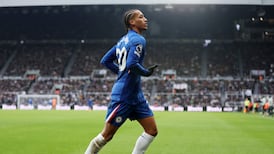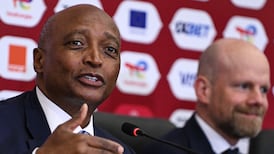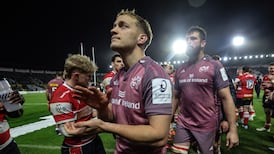"When I played Connors, I'd look at him and think: am I trying as hard as this guy?" John McEnroe recalled as he watched Rafael Nadal in the midst of one of his rhapsodic furies at the Australian Open.
This was on Friday morning and like everyone else in the Rod Laver arena, McEnroe gave the impression of a fan whose nerves were frazzled by what was unfolding before his eyes.
Long before it ended, it was clear that Nadal and Grigor Dimitrov were locked into one of the best tennis matches ever played. Sometimes, when tennis takes the mood; when two of its stars go supernova, then all other ball sports just seem like huff and puff in comparison.
Already, the play had to be halted a critical point of the third set when a fan collapsed in the crowd. McEnroe sounded concerned but not entirely surprised; even the millions of fans around the world could sense that the mood in the arena was unusual, the crowd was vividly gripped.
Nadal was trailing 5-4 and serving to stay in the set and both players visibly had the jitters as they waited for the medics do take care of the fallen fan, their legs shaking as they sat on their benches before they both began hitting air strokes just to burn off the nervous energy.
The reason, of course, that so much emotional freight had been invested in this semi-final is that Roger Federer had already made it through for to Sunday's final and the spectators couldn't really disguise the fact that they were aching for the unexpected, impossible gift of seeing Nadal versus Federer for what surely would be one last time in a Grand Slam final.
Federer has not won a Grand Slam title for five years, when he captured his eighth Wimbledon title. Nadal hasn’t lifted Grand Slam silverware since 2013.
Both men have spent months away from the circuit to try and fix machines – their bodies – that are slowly beginning to betray them. When pitched against each other they seemed to offer the perfect sporting contrast: Total Effort versus Total Effortlessness.
Intimidating aura
Against Dimitrov, Nadal once again unveiled the depthless leagues of his hunger for the win, attacking every ball and then pulverising it, as if said ball had just uttered something despicable about his grandmother.
Nadal has been kicking about the title-winning scene of elite tennis with his mega-guns and glowering exhortations for 13 years. Yet he still plays every single shot with furious vengeance and hits every ball with that mournful howl of anguish.
The odd thing about Nadal is that he manages to bring this intimidating aura onto the court without ever being a jerk or disrespectful towards his opponent. Whatever demons he is battling are demonstrably his own.
And it’s difficult to watch Nadal playing tennis matches that go all the way without fearing for the guy once he reaches that state where every muscle and fibre he possesses are visibly pulsing with the physical and emotional strain of what he is going through.
So it was on Friday: a third set lasting 70 minutes (!): three hours and 52 minutes on the clock just going into the fifth set – and the opening game of that defining passage featuring a 20-shot rally and an advantage-deuce trade which brought the game to 13 minutes.
It’s also excruciating watching anybody playing Nadal in those ferocious baseline rallies because the Spaniard is incapable of flinching or breaking. There is the sense that if Nadal could play Nadal – someone of his own physiological and temperamental equivalent – he would end up in a rally that could only end when of them fainted with exhaustion.
“No substitutions. Nobody but yourself out there. Who’s gonna crack?” McEnroe wondered at 3-3 and 30-30 in the fifth set. By then, it was after midnight and still hot and the last night trains into Melbourne city centre had gone but nobody was leaving the arena.
Sport like this does not come around very often. Dimitrov, the younger challenger who has been cursed with the ‘Baby Fed’ tag because of the preternatural grace of his movement and the easy accuracy of his whipcord back hand, responded to the Spaniard’s fury with depths of resolve hitherto unseen.
A colossus
Lauded early, plied with lucrative contracts, born with the kind of unthreatening handsomeness peculiar to tennis stars – as if, in a parallel world a starring role in a mid-afternoon medical soap opera would surely have been his – Dimitrov, at 25, came into this tournament yet to deliver on all the gifts.
And now, with a stadium feverishly rooting for the senior player, he played like a colossus. But Nadal is ridiculous. He was 15-40 down and facing the moment of honourable defeat when he suddenly, without warning, summoned yet another reserve of passion, holding that serve, then breaking the young Bulgarian before winning the match in a nerve-wracking final game, after which he promptly collapsed on the court.
With the Williams sisters playing in an equally unexpected women’s final on Saturday, this year’s Australian Open had distinguished itself anyway.
But this reunion of Federer and Nadal takes it into a different realm. It will be nine full years this July since they played that amazing Wimbledon final, with its 9-7 fifth set win for Nadal in failing summer light.
And it is, poignantly, over a decade now since the late David Foster Wallace wrote his perfect ode to the then "appallingly young" Swiss star – 'Federer As Religious Experience', when he attended the 2006 Wimbledon tournament in which the pair met in Centre Court on final Sunday: "the passionate machismo of Southern Europe versus the clinical artistry of the north". It was, if you recall, the era during which Federer had taken to wearing blazer-type warm up jackets of the Brideshead Revisited era.
“‘The Swiss is in the buttermilk sports coat that Nike’s gotten him to wear for Wimbledon this year. On Federer, and perhaps on him alone, it doesn’t look absurd with shorts and sneakers. The Spaniard eschews all warm-up clothing, so you have to look at his muscles straight away.”
One of the arguments of his essay is that however astonishing Federer looks playing tennis on television, the scope of his artistry and athleticism can only fully be appreciated by the naked eye. Anyone fortunate enough to have seen a major tennis match live knows the truth of that: the TV lens can’t accurately communicate the sound of the ball being hit that hard and accurately nor the speed at which it travels nor the anticipation of the players.
There is no question that anyone heading along to Sunday’s final has in their hands one of the most coveted sports tickets of modern times. The rest of us will have to make do with the box – and the brilliant consolation of having McEnroe talk us through Federer versus Nadal long after we figured that riff had concluded.
It promises to be one of those very rare sports events which transcend the hype and nonsense, dwelling in its own earned history and deepened by the fact that two of the greatest ever players have made it back to this shore against all odds.
You won’t be able to look away – if you can even bear to watch.










